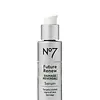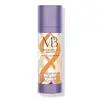What's inside
What's inside
 Key Ingredients
Key Ingredients

 Benefits
Benefits

 Concerns
Concerns

 Ingredients Side-by-side
Ingredients Side-by-side

Water
Skin ConditioningDimethicone
EmollientButylene Glycol
HumectantGlycerin
HumectantMethyl Gluceth-20
HumectantIsononyl Isononanoate
EmollientPolysilicone-11
Niacinamide
SmoothingPhenoxyethanol
PreservativeAcrylates/Beheneth-25 Methacrylate Copolymer
Tocopheryl Acetate
AntioxidantSilica
AbrasivePanthenol
Skin ConditioningPolysorbate 20
EmulsifyingCaprylyl Glycol
EmollientAmmonium Acryloyldimethyltaurate/Vp Copolymer
Potassium Hydroxide
BufferingXanthan Gum
EmulsifyingSodium Hyaluronate
HumectantHydrolyzed Rice Protein
Skin ConditioningDecyl Glucoside
CleansingPropylene Glycol
HumectantEthylhexylglycerin
Skin ConditioningAscorbyl Glucoside
AntioxidantPropanediol
SolventPentylene Glycol
Skin ConditioningTetrasodium EDTA
Hexylene Glycol
EmulsifyingT-Butyl Alcohol
PerfumingSodium Benzoate
MaskingMorus Alba Leaf Extract
Skin ConditioningPalmitoyl Tetrapeptide-94
Palmitoyl Tetrapeptide-95
Water, Dimethicone, Butylene Glycol, Glycerin, Methyl Gluceth-20, Isononyl Isononanoate, Polysilicone-11, Niacinamide, Phenoxyethanol, Acrylates/Beheneth-25 Methacrylate Copolymer, Tocopheryl Acetate, Silica, Panthenol, Polysorbate 20, Caprylyl Glycol, Ammonium Acryloyldimethyltaurate/Vp Copolymer, Potassium Hydroxide, Xanthan Gum, Sodium Hyaluronate, Hydrolyzed Rice Protein, Decyl Glucoside, Propylene Glycol, Ethylhexylglycerin, Ascorbyl Glucoside, Propanediol, Pentylene Glycol, Tetrasodium EDTA, Hexylene Glycol, T-Butyl Alcohol, Sodium Benzoate, Morus Alba Leaf Extract, Palmitoyl Tetrapeptide-94, Palmitoyl Tetrapeptide-95
Water
Skin ConditioningCyclopentasiloxane
EmollientGlycerin
HumectantNeopentyl Glycol Diheptanoate
EmollientPentylene Glycol
Skin ConditioningCastor Isostearate Succinate
Skin ConditioningButylene Glycol
HumectantPolymethylsilsesquioxane
C30-45 Alkyl Cetearyl Dimethicone Crosspolymer
EmollientDimethicone Crosspolymer
Emulsion StabilisingCucumis Melo Fruit Extract
Skin ConditioningElaeis Guineensis Oil
EmollientHydrogenated Vegetable Oil
EmollientTocopheryl Acetate
AntioxidantSodium Hyaluronate
HumectantMagnesium Ascorbyl Phosphate
AntioxidantSoluble Collagen
HumectantMaltooligosyl Glucoside
Skin ConditioningCaprylyl Glycol
EmollientDecarboxy Carnosine Hcl
Skin ConditioningHexapeptide-9
Skin ConditioningTripeptide-3
Skin ConditioningSaccharomyces/Zinc Ferment
Skin ConditioningCholesterol
EmollientTocotrienols
Skin ConditioningTocopherol
AntioxidantDimethicone
EmollientEthylhexylglycerin
Skin ConditioningGlyceryl Acrylate/Acrylic Acid Copolymer
HumectantEthylhexyl Hydroxystearate
EmollientHydrogenated Phosphatidylcholine
EmulsifyingSilica Dimethyl Silylate
EmollientHydrogenated Starch Hydrolysate
HumectantHydroxypropyl Guar
Emulsion StabilisingPolysilicone-11
Aminomethyl Propanol
BufferingHexylene Glycol
EmulsifyingAlcohol
AntimicrobialDisodium EDTA
Carbomer
Emulsion StabilisingPhenoxyethanol
PreservativeParfum
MaskingAlpha-Isomethyl Ionone
PerfumingBenzyl Benzoate
AntimicrobialBenzyl Salicylate
PerfumingButylphenyl Methylpropional
PerfumingCitronellol
PerfumingGeraniol
PerfumingHexyl Cinnamal
PerfumingLimonene
PerfumingLinalool
PerfumingIron Oxides
CI 77891
Cosmetic ColorantWater, Cyclopentasiloxane, Glycerin, Neopentyl Glycol Diheptanoate, Pentylene Glycol, Castor Isostearate Succinate, Butylene Glycol, Polymethylsilsesquioxane, C30-45 Alkyl Cetearyl Dimethicone Crosspolymer, Dimethicone Crosspolymer, Cucumis Melo Fruit Extract, Elaeis Guineensis Oil, Hydrogenated Vegetable Oil, Tocopheryl Acetate, Sodium Hyaluronate, Magnesium Ascorbyl Phosphate, Soluble Collagen, Maltooligosyl Glucoside, Caprylyl Glycol, Decarboxy Carnosine Hcl, Hexapeptide-9, Tripeptide-3, Saccharomyces/Zinc Ferment, Cholesterol, Tocotrienols, Tocopherol, Dimethicone, Ethylhexylglycerin, Glyceryl Acrylate/Acrylic Acid Copolymer, Ethylhexyl Hydroxystearate, Hydrogenated Phosphatidylcholine, Silica Dimethyl Silylate, Hydrogenated Starch Hydrolysate, Hydroxypropyl Guar, Polysilicone-11, Aminomethyl Propanol, Hexylene Glycol, Alcohol, Disodium EDTA, Carbomer, Phenoxyethanol, Parfum, Alpha-Isomethyl Ionone, Benzyl Benzoate, Benzyl Salicylate, Butylphenyl Methylpropional, Citronellol, Geraniol, Hexyl Cinnamal, Limonene, Linalool, Iron Oxides, CI 77891
 Reviews
Reviews

Ingredients Explained
These ingredients are found in both products.
Ingredients higher up in an ingredient list are typically present in a larger amount.
Butylene Glycol (or BG) is used within cosmetic products for a few different reasons:
Overall, Butylene Glycol is a safe and well-rounded ingredient that works well with other ingredients.
Though this ingredient works well with most skin types, some people with sensitive skin may experience a reaction such as allergic rashes, closed comedones, or itchiness.
Learn more about Butylene GlycolCaprylyl Glycol is a humectant and emollient, meaning it attracts and preserves moisture.
It is a common ingredient in many products, especially those designed to hydrate skin. The primary benefits are retaining moisture, skin softening, and promoting a healthy skin barrier.
Though Caprylyl Glycol is an alcohol derived from fatty acids, it is not the kind that can dry out skin.
This ingredient is also used as a preservative to extend the life of products. It has slight antimicrobial properties.
Learn more about Caprylyl GlycolDimethicone is a type of synthetic silicone created from natural materials such as quartz.
What it does:
Dimethicone comes in different viscosities:
Depending on the viscosity, dimethicone has different properties.
Ingredients lists don't always show which type is used, so we recommend reaching out to the brand if you have questions about the viscosity.
This ingredient is unlikely to cause irritation because it does not get absorbed into skin. However, people with silicone allergies should be careful about using this ingredient.
Note: Dimethicone may contribute to pilling. This is because it is not oil or water soluble, so pilling may occur when layered with products. When mixed with heavy oils in a formula, the outcome is also quite greasy.
Learn more about DimethiconeEthylhexylglycerin (we can't pronounce this either) is commonly used as a preservative and skin softener. It is derived from glyceryl.
You might see Ethylhexylglycerin often paired with other preservatives such as phenoxyethanol. Ethylhexylglycerin has been found to increase the effectiveness of these other preservatives.
Glycerin is already naturally found in your skin. It helps moisturize and protect your skin.
A study from 2016 found glycerin to be more effective as a humectant than AHAs and hyaluronic acid.
As a humectant, it helps the skin stay hydrated by pulling moisture to your skin. The low molecular weight of glycerin allows it to pull moisture into the deeper layers of your skin.
Hydrated skin improves your skin barrier; Your skin barrier helps protect against irritants and bacteria.
Glycerin has also been found to have antimicrobial and antiviral properties. Due to these properties, glycerin is often used in wound and burn treatments.
In cosmetics, glycerin is usually derived from plants such as soybean or palm. However, it can also be sourced from animals, such as tallow or animal fat.
This ingredient is organic, colorless, odorless, and non-toxic.
Glycerin is the name for this ingredient in American English. British English uses Glycerol/Glycerine.
Learn more about GlycerinHexylene Glycol is a surfactant. Glycols are a class of alcohols. Hexylene Glycol is a surfactant and emulsifier.
As a surfactant, Hexylene Glycol helps gather dirt and oil on your skin to be washed away.
As an emulsifier, Hexylene Glycol helps keep water and oil together. This prevents them from separating in a product. Hexylene Glycol also thins out the texture of a product by lessening viscosity.
Hexylene Glycol has a small molecular weight.
Learn more about Hexylene GlycolPentylene glycol is typically used within a product to thicken it. It also adds a smooth, soft, and moisturizing feel to the product. It is naturally found in plants such as sugar beets.
The hydrophilic trait of Pentylene Glycol makes it a humectant. As a humectant, Pentylene Glycol helps draw moisture from the air to your skin. This can help keep your skin hydrated.
This property also makes Pentylene Glycol a great texture enhancer. It can also help thicken or stabilize a product.
Pentylene Glycol also acts as a mild preservative and helps to keep a product microbe-free.
Some people may experience mild eye and skin irritation from Pentylene Glycol. We always recommend speaking with a professional about using this ingredient in your routine.
Pentylene Glycol has a low molecular weight and is part of the 1,2-glycol family.
Learn more about Pentylene GlycolPhenoxyethanol is a preservative that has germicide, antimicrobial, and aromatic properties. Studies show that phenoxyethanol can prevent microbial growth. By itself, it has a scent that is similar to that of a rose.
It's often used in formulations along with Caprylyl Glycol to preserve the shelf life of products.
Polysilicone-11 is a film-forming silicone that creates a non-tacky and matte finish on the skin. It's commonly used to improve texture, absorb excess oil, and help active ingredients spread evenly.
Due to its "rubber-like" structure, it stays on the skin's surface instead of being absorbed. On the skin, it creates a flexible layer that enhances wearability and stability.
Sodium Hyaluronate is hyaluronic acid's salt form. It is commonly derived from the sodium salt of hyaluronic acid.
Like hyaluronic acid, it is great at holding water and acts as a humectant. This makes it a great skin hydrating ingredient.
Sodium Hyaluronate is naturally occurring in our bodies and is mostly found in eye fluid and joints.
These are some other common types of Hyaluronic Acid:
Learn more about Sodium HyaluronateTocopheryl Acetate is AKA Vitamin E. It is an antioxidant and protects your skin from free radicals. Free radicals damage the skin by breaking down collagen.
One study found using Tocopheryl Acetate with Vitamin C decreased the number of sunburned cells.
Tocopheryl Acetate is commonly found in both skincare and dietary supplements.
Learn more about Tocopheryl AcetateWater. It's the most common cosmetic ingredient of all. You'll usually see it at the top of ingredient lists, meaning that it makes up the largest part of the product.
So why is it so popular? Water most often acts as a solvent - this means that it helps dissolve other ingredients into the formulation.
You'll also recognize water as that liquid we all need to stay alive. If you see this, drink a glass of water. Stay hydrated!
Learn more about Water